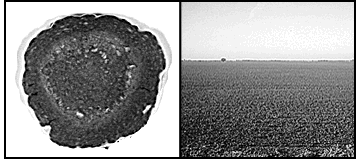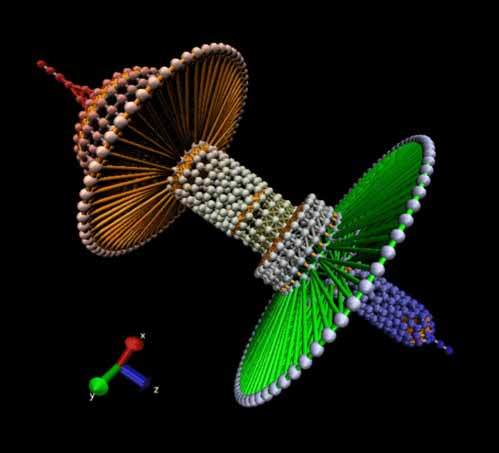Marc Abrahams's Blog, page 292
December 11, 2015
There be Quantum Dragons
Improbable can say, with some confidence, that no-one has even seen a ‘Quantum Dragon’. But that shouldn’t be taken to mean that they don’t exist. Dr. Mark A. Novotny Professor and Head of the Department of Physics and Astronomy at the HPC² Center for Computational Sciences, Mississippi State University, US, asserts that they do – and he was the first to describe (and name) them in his paper ‘Energy-independent total quantum transmission of electrons through nanodevices with correlated disorder’ Phys. Rev. B 90, 165103 – Published 3 October 2014.
This illustration from the paper shows (an artist’s impression of) how a nine-part Quantum Dragon might look, if it could, in any normal sense of the word, be seen.

December 10, 2015
Discourse analysis of men’s online groin shaving talk (new study)
It could be said that not all that much academic attention has been afforded to discourse analysis of men’s online groin shaving talk. One, perhaps the only, published exception is a new paper in the journal Sexualities, December 2015, vol. 18 no. 8 997-1017 ‘When there’s no underbrush the tree looks taller’: A discourse analysis of men’s online groin shaving talk.
Author Dr Matthew Hall who is a Research Associate at the Department: Health Research of Lancaster University, UK, provides a full copy of the paper here [s.f.w.]
Note: The paper cites a link to this page hosted by razor manufacturer Gillette, where the video above can be found.
Bonus: ‘Bring out the 007 in You’ (according to Gillette)

December 9, 2015
Podcast 41: Kansas is Flatter Than a Pancake (and water, and holes)
The discovery that Kansas is flatter than a pancake, comparative water preferences of female college students and rats, and deep thoughts about the shape of holes — all of these turn up in this week’s Improbable Research podcast.
LISTEN TO IT! …or click on the “Venetian blinds” icon — at the lower right corner here — to select whichever week’s episode you want to hear:
SUBSCRIBE on Play.it, iTunes, or Spotify to get a new episode every week, free.
This week, Marc Abrahams tells about:
Kansas Is Flatter Than a Pancake. (“Kansas is Flatter Than a Pancake“, Mark Fonstad, William Pugatch, and Brandon Vogt, Annals of Improbable Research, vol 9, no. 3, May-June 2003, pp. 16-18. Featuring dramatic readings by Jean Berko Gleason.) Here are photos showing a pancake (on the left) and Kansas:

Water Preferences of Female College Students and Rats. (Yukiko, Esumi, and Ohara Ikuo (1999). ‘Similar Preference for Natural Mineral Water between Female College Students and Rats.’ Journal of Home Economics of Japan 50 (12): 1217–22. / Lathan, C., and P. E. Fields (1936). ‘A Report on the Test-retest Performances of 38 College Students and 27 White Rats on the Identical 25 Choice Elevated Maze.’ Journal of Genetic Psychology 49: 283–96. Featuring dramatic readings by Daniel Rosenberg.)

A Hole, in the Head. (Bertamini, Marco, and Camilla J. Croucher (2003). ‘The Shape of Holes.’ Cognition 87 (1): 33–54. / Lewis, David Kellogg, and Stephanie R. Lewis (1970). ‘Holes.’ Australasian Journal of Philosophy 48: 206-12; reprinted in Lewis, D. K. (1983). Philosophical Papers, vol. 1. New York: Oxford University Press, 3–9. / Norman, J. F., F. Phillips, and H. E. Ross (2001). ‘Information Concentration Along the Boundary Contours of Naturally Shaped Solid Objects.’ Perception 30: 1285–94. Featuring dramatic readings by Melissa Franklin.)
The mysterious John Schedler or the shadowy Bruce Petschek perhaps did the sound engineering this week.
The Improbable Research podcast is all about research that makes people LAUGH, then THINK — real research, about anything and everything, from everywhere —research that may be good or bad, important or trivial, valuable or worthless. CBS distributes it, on the CBS Play.it web site, and on iTunes and Spotify).

December 8, 2015
Literary critic: 2001
Niels Berg Olsen writes:
I love all your books, and therefore I have read them all more than once.
Reading iG Nobel Prizez 2 for the 2+1=third time I noticed an error on p.169. You mention that D Schmidt won a 1999 prize. He did not. He won it in 2001.
Niels Olsen
Denmark

fMRI of the Brains of People Eating High and Low Quality Steak
A further innovation in the study of the brain, and/or in the study of people eating cooked meat:
“Neural connectivity of the right and left nucleus accumbens after eating high and low quality steak,” W.N. Tapp, T.H. Davis, D. Paniukov, and Markus F. Miller [pictured below], Meat Science, vol. 112, February 2016, p. 113. The authors, at Texas Tech University, report:
“Functional magnetic resonance imaging (fMRI) has evaluated activation of brain regions after consumption of many foods, but researchers have yet to capitalize this technology to analyze many solid foods such as steak…. The objective of this experiment was to evaluate brain connectivity to the right and left nucleus accumbens after consuming different steak qualities….
“Conclusion: [Our] data suggest that connected regions respond to different qualities of steak differently. A general increase in connectivity to the right and left nucleus accumbens was observed in the hippocampus and medial orbitofrontal cortex after consuming high quality steak.”

December 7, 2015
“Of Mice and Men” research poetry
The proprietor of the EasternBlot blog has made (wrought?) a poem entirely from the titles of 40 academic articles that begin with the phrase “Of Mice and Men”. The poem begins:
Of mice and men.2
Of mice and men, metals and mutations.3
Of mice and men, corticosteroids, and vicarious participation.4
Of mice and men–universality and breakdown of behavioral organization.5
Of mice and men: the riddle of tubular regeneration.6
…
References
Nomura, T. Of mice and men? Nature 345, 671 (1990).
Martin, J. B. Of mice and men. Nature 307, 10 (1984).
Danks, D. M. Of mice and men, metals and mutations. J Med Genet 23, 99–106 (1986).
Laudenslager, M. L. Of mice and men, corticosteroids, and vicarious participation. Brain Behav Immun 18, 414–415 (2004).
The full poem is accompanied by citations for each of those studies.
(Thanks to Rolf Zwaan for bringing this to our attention.)

Static electricity – we’re still (somewhat) in the dark
You might think that 2.6 millennia* of scientific study would be enough to form a thorough and complete understanding of a phenomenon as ubiquitous as ‘static electricity’. Not so, says a foremost authority on the subject, the Electrostatics Society of America.
“Electrostatics is an exciting area of science, as its most basic scientific questions remain unknown and highly controversial … and yet its consequences are widespread. For example, the identity of the species transferred to generate charge when materials rub is being hotly debated in the leading scientific journals – some researchers argue that it is electrons, others that it is ions, and yet others that it is bits of material.”
Also see (static related) : Electricity and the colour of socks
* Note: The earliest written scientific accounts of ‘static electricity’ are believed to be those of Thales of Miletus, c. 600BC. He thought (correctly, but for the wrong reasons) that it was linked in some way to magnetism.

December 6, 2015
Arisia: Nominate a reader for our Jan. 15th event

Calling all Arisia fen: Improbable Research will return to Arisia on Friday, January 15, 2016 and we’re asking the fen to help us find the best people to present some of our research papers.
(There are a limited number of these reader positions)
What qualities should the person you nominate have to be a reader at this event:
Charismatic stage presence
Good speaking voice
Able to read clearly into a microphone
Not easily rattled when asked strange questions about a research paper they have only just read themselves
(most important) Attending Arisia on Friday Jan 15, 2016
This Arisia event will include a number of brief, dramatic readings from studies and patents that have won an Ig Nobel prize. Shortly before this event begins, we will supply our Readers with a selection of papers to choose between.

Do you know someone who should be illuminated by The Human Spotlight? (photo by D. Kessler)
They choose one, and then find the portions of it they want to read – or present in some other dramatic manner – to the audience.
Each presentation will be 2 minutes long, after which the Reader may (if they wish) entertain questions from the audience. In answering these questions, they may draw from the paper or from their personal experience. They may surmise or deflect, but they must not lie.
NOMINATIONS
If you know people like this then please go to our nomination page and tell us that they would be good readers for this Ig-Arisia event (perhaps you’ll also tell us why they would be good readers).
If you would like to know people like this, then head to our nomination page to see who has already been nominated.
We encourage you to nominate attendees, staff, vendors, or other unexpected people who would do a good job (see the list of qualities, above).

Raven: Lunatic
In 1929, Alice Raven wrote a distinctive essay about lunatics:
“Murder and Suicide as Marks of an Abnormal Mind,” Alice Raven, The Sociological Review, vol. a21, no. 4, October 1929, pp. 315–333. The article is prefaced by a warning from the editor. The author then begins by saying: “One of the most disturbing features of social life at the present day is the outcrop of murders and suicides which appear as an excrescence on current civilization.”
Raven was oft quothed. She wrote extensively on the general subject. Among her other publications:
“A Contribution Towards a Psychological Conception of Insanity and Its Relation to Crime,” Alice Raven, The Sociological Review, vol. a20, no. 4, 1928, pp. 274-292.

December 5, 2015
Candied orange agony: “I continue to control the hell out of the variables”
 Ann Finkbeiner writes about the tricky chemistry and physics of candied orange peel made according to the recipe of a Hungarian physicist’s grandmother. Here’s a passage from the middle of the lament:
Ann Finkbeiner writes about the tricky chemistry and physics of candied orange peel made according to the recipe of a Hungarian physicist’s grandmother. Here’s a passage from the middle of the lament:
…The recipe no longer works. I continue to control the hell out of the variables. I use the same amount of orange peel, two-oranges-worth, every time. I use the same 1:1 ratio of water to sugar and the same absolute amounts, 1.5 cups each. I use a pan of the same size, the same stingy amount of stirring, the same low simmer until the water gradually boils off and bubbles foam on top of bubbles, and no liquid remains. I get them out of the pan fast, spread them on plates, let them cool. They’re tooth-chippingly hard, they’re like glass. I throw out whole batches of them, though the Hungarian physicist says, on consult, that if he leaves one in his mouth it eventually melts. After an hour or something, maybe a whole afternoon. I am in despair, I can talk of nothing else.…
BONUS (possibly unrelated): A delicious cooking video, by PES:

Marc Abrahams's Blog
- Marc Abrahams's profile
- 14 followers






